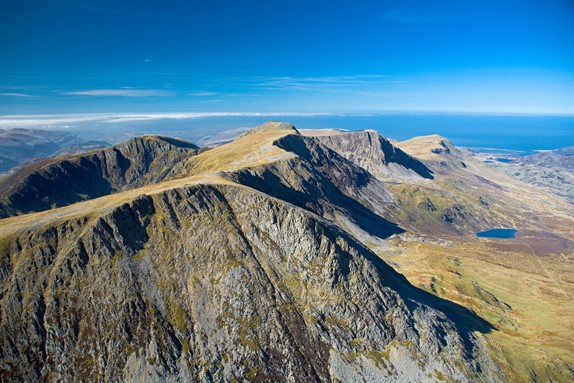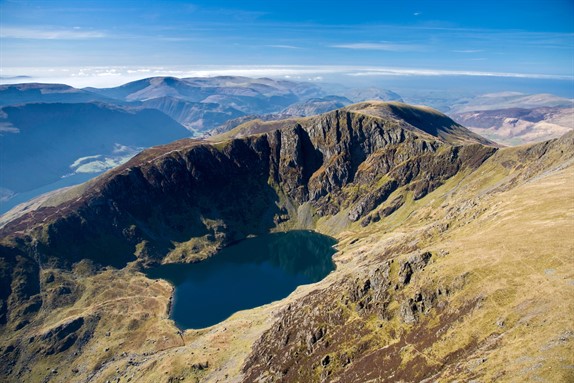Posted on 04/07/2018 by David
North Wales is known for rugged landscapes – sweeping coastlines, rolling hills, flowing waterways – but is perhaps most well-known for its towering mountains.
In this new series, we’ll be shining a (very tall) spotlight on some of our rocky giants, that have defined the landscape and influenced our culture since time immemorial. There’s plenty of folklore and legend around here, and every mountain worth its salt has some truly tall tales to tell. So, settle in and be inspired by our magnificent mountains.

Cadair Idris
We’ve chosen the majestic Cadair Idris as our first mountain to showcase. Located in the south of the Snowdonia National Park, this is a popular peak among walkers, hikers and adventurers. Standing at an impressive 893 metres, the views from the summit – called Pen Y Gadair – are showstopping.
Sometimes known as Snowdon’s twin, Cadair Idris is in fact made up of many of the same types of rock as Wales’ most famous mountain and bears a similar geological profile.
What’s in a name?
There is some controversy over the mountain’s proper name, with disagreement over whether it should be known as Cadair Idris or Cader Idris.
Cadair Idris means ‘Chair of Idris’, while ‘cader’ can be translated as ‘fort’. It’s now widely accepted that ‘Cader Idris’ was simply the phonetic writing of the local dialect’s pronunciation of ‘cadair’. In fact, despite advice from the Welsh Language Commission, Snowdonia National Park has used the local dialect’s ‘cader’ on signage for the last two years; the decision reflects the strong presence of history and lore in Welsh culture, and demonstrates the importance of local heritage on place names.
Who was Idris?
Idris was a warrior king of Meirionydd, Idris ap Gwyddno (c.560 – 632). Legend tells that Idris the Giant, or Idris Gawr, was so large that he could use the mountain as a chair to sit on and look out over his kingdom!
It’s possible that Gawr might have originally come from Idris Arw (Idris the Coarse), though we think Idris the Giant is a much grander title.

Myths and legends
In addition to the folklore surrounding Idris and his questionable height, a mythical, utterly magical locale like this is always bound to be associated with legends.
A popular old wives’ tale says that anyone who sleeps overnight on Cadair Idris will awake as either a poet or a madman!
Another story goes that Idris was one day sitting at the top of the mountain, and picked some irritating pieces of grit from his shoe, and threw them aside. The three huge boulders that sit at the base of the mountain are said to be these very pieces of grit, part of Idris’ indelible legacy.
Some people claim that this imposing mountain landscape was also the hunting ground of Gwyn ap Nudd. Ap Nudd was the ruler of the Underworld in Welsh folklore, and hunted the land around Cadair Idris for souls, accompanied by his pack of red-eared phantom hounds, whose howls were said to mean death for anyone unfortunate enough to hear them.
Llyn Cau, Cadair Idris’ crater lake surrounded by a dramatic wall of mountain, is also part of the folklore of the area. The lake is supposed to be bottomless, and also home to a fearsome Welsh dragon!
Click here to see a video about the mountain’s legends, and stop at the Cadair Idris Visitor Centre for more information.

Exploring Cadair Idris
There are four main walking routes up to the summit, and it’s well worth the climb for the awe-inspiring views you’ll get at the top. As with all hiking in Wales, we recommend ensuring you’ve got the correct equipment and preparing for all weather!
Llanfihangel-y-Pennant Path
Although an easy enough climb, this is the longest footpath up to the summit. Five miles each way, it’s recommended to take at least seven hours to walk. The route begins in Llanfihangel-y-Pennant and offers amazing views out over Mawddach Estuary. Just below the summit there’s a shelter, which is the perfect place to stop for a break.
Pony Path
Considered the least taxing route up the mountain, this path is about three miles each way, and will likely take between five and six hours to climb up from the starting point at Ty Nant. Keep your eyes peeled for amazing vistas of the National Park.
Minffordd Path
This route begins next to the Cadair Idris Visitor Centre, and is the shortest (safe) path to the top. This trail takes you past Llyn Cau for spectacular views. Minffordd Path takes between five to six hours; please note, there is a steep climb involved which may be challenging for non-experienced walkers and hikers.
Fox's Path
This is the most direct footpath, and starts from the shores of Llyn Gwernan. The route is just two and a half miles long, though this is probably the most difficult path to traverse, with a 1,000-foot climb. We suggest only experienced and confident climbers tackle this path.
Rest and refreshments
The Ty Te Cadair Tea Room by the Visitor Centre is a lovely stop for a light lunch or a well-earned cake post-climb. If you chose to take Fox’s Path, Gwernan Lake Hotel is a great place for a drink, while those walking the Minffordd Path can choose to stop at Gwesty Minffordd.
Stay nearby
For a list of our cottages in southern Snowdonia look here.
Not quite what you're looking for? Browse all our cottages here.
Images courtesy: © Crown copyright (2012) Visit Wales, all rights reserved.

